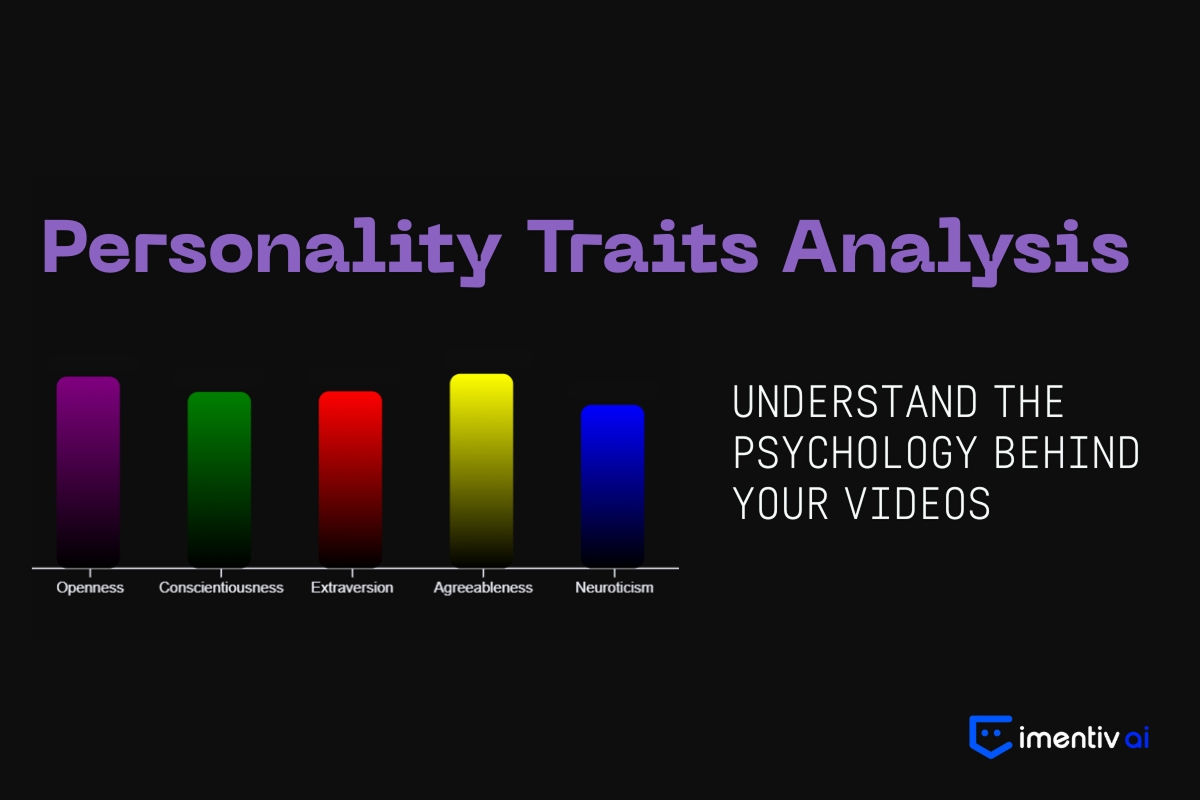
Personality Traits Analysis: Turning Emotions into Psychological Insights
Personality Traits Analysis is an Imentiv AI feature that identifies the psychological tone of your video content. It provides insights into how your audience perceives the overall personality behind the message. This is done by analyzing emotions expressed through faces, voices, and words.
Rather than evaluating individuals in isolation, our emotion AI looks at the collective emotional behavior of the group or speakers. These patterns are then mapped to the Big Five personality model (OCEAN), resulting in a psychological snapshot that highlights whether your content conveys openness, conscientiousness, extraversion, agreeableness, or neuroticism.
The Big Five Personality Model
.png?alt=media&token=26c0d958-0117-46fc-88d4-a0c8bb6b1a63)
The Big Five, also known as OCEAN, is the most widely used psychological framework for describing personality:
- Openness – Creativity, imagination, and curiosity.
- Conscientiousness – Organization, reliability, and discipline.
- Extraversion – Sociability, enthusiasm, and energy.
- Agreeableness – Empathy, cooperation, and kindness.
- Neuroticism – Emotional sensitivity, stress, and reactivity.
Imentiv AI uses this framework to transform raw emotional signals into a clear personality profile of your video.
From Emotions to Traits
Personality is revealed through patterns, not single moments. Imentiv AI analyzes facial expressions such as joy, anger, fear, or surprise, along with vocal qualities like pitch, intensity, and rhythm. It also considers the language used, paying attention to word choice and phrasing that signal underlying mood and intent. Together, these elements provide a comprehensive view of the emotional landscape within a video.
Beyond detecting emotions, Imentiv AI examines how they behave over time. It looks at consistency to see whether emotions remain stable or fluctuate, synchrony to understand whether participants mirror or diverge from each other, and duration to determine if expressions are fleeting or sustained. These dynamics form the foundation for translating raw emotions into personality traits.
Through these dynamics, Imentiv AI identifies personality tones.
For example:
- Curiosity, imagination, and emotionally engaged expressions may signal openness.
- Steady confidence and structured delivery may reflect conscientiousness.
- Expressive energy and enthusiasm may suggest extraversion.
- Warmth, empathy, and cooperative exchanges may indicate agreeableness.
- Signs of stress, tension, or defensiveness may lean towards neuroticism.
The analysis focuses on the psychological climate of the video as a whole, not on labeling individuals.
Clear, Color-Coded Results
.jpg?alt=media&token=ad29fd70-4e56-4fe2-8c66-8c632853a27a)
Imentiv AI presents results in a simple, color-coded bar chart. Each bar represents one of the Big Five traits:
- Purple (Openness) - represents imagination, creativity, and curiosity, highlighting individuals or content open to new ideas and unique perspectives.
- Green (Conscientiousness) - signals stability, balance, and cooperative behavior, reflecting reliability and a harmonious approach.
- Red (Extraversion) - indicates energy, confidence, and enthusiasm, often linked to outgoing and passionate personalities.
- Yellow (Agreeableness) - associated with cheerfulness, creativity, and a bright, engaging demeanor.
- Blue (Neuroticism) - reflects emotional stability, thoughtfulness, and a composed, reflective approach.
This visual output makes it easy to:
- Compare personality traits across multiple videos.
- Track how personality traits shift across videos.
- Align content with audience preferences or brand identity.
Why Personality Matters
Imentiv AI’s Personality Traits Analysis ensures your content delivers the right tone. It highlights whether your video communicates confidence, empathy, creativity, or authority, and shows how closely it aligns with your brand’s personality. By translating emotional dynamics into clear psychological insights, the feature helps you refine messaging, compare videos, and strengthen audience connection.